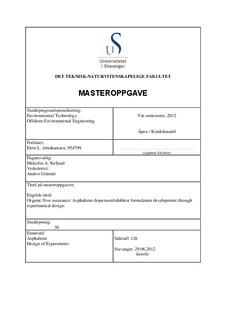Organic flow assurance: Asphaltene dispersant/inhibitor formulation development through experimental design
Master thesis
Permanent lenke
http://hdl.handle.net/11250/182547Utgivelsesdato
2012Metadata
Vis full innførselSamlinger
Sammendrag
The exploitation of hydrocarbon has forced the petroleum production to move closer to
extreme climate areas and deep waters such as the Barents Sea. These challenges require
effective and safe production, transport and processing of the petroleum sources.
Chemical and physical changes in the reservoir may cause different types of unpredicted
problems such as organic deposits which are mainly asphaltene and wax precipitation. Wax
precipitation is very common in subsea pipelines. Asphaltenes are more affected by for
example pressure drops and high shear, which may cause formation damage as well as plugup
the well-bores and tubing.
In the petroleum industry, flow assurance has become a key concern where the cold sea
bottom temperatures and extreme water depths give rise to enormous technical challenges
which includes the management of solids such as asphaltenes and wax. Flow assurance is
defined as “safe, uninterrupted and simultaneous transport of gas, oil and water from
reservoirs to processing facilities”. The term refers to the need to guarantee flow of oil and
gas from the reservoirs to the processing facilities.
In this thesis the focus will be on chemical control of asphaltene and the formulation of an
optimal asphaltene dispersant mixture.
An experimental method needed to be established for the screening tests of the dispersant
mixtures. When performing a screening test, the experimental method is desired to be simple
and quick. This will save time and money as the screening test will only give an idea of how
the system works and interacts. Different methods were tested such as measurement of the
asphaltene deposit level, spot test, UV-Vis spectroscopy and turbidity measurements.
Turbidity measurement was decided to be used in the formulation of an optimal asphaltene
dispersant mixture.
Design of experiments (DoE) and mixture design are well known methods which are often
used when mixing together multiple components. DoE techniques provide an idea of how the
mixtures work together and can then optimize the formulation at a minimum effort and cost.
The computer software, Design Expert was used for the experimental design in this thesis.
The program was used to set up an experimental plan which showed the mixture components
and the mixture proportions to be tested. When the results were ready, they were inserted in
Design Expert and a model was suggested. The analysis of the model was also done by
Design Expert which made it possible to easily detect certain trends in the model such as
identifying results that deviated from the model in form of failed experiments.
Three different crude oils were tested, Crudo-Metapetroleum a viscous and heavy crude oil
with an asphaltene content of 12,1535g/100ml, Hier D02A crude oil which is a more common
crude oil with an asphaltene content of 2,2380g/100ml and Jordbær crude oil with an
asphaltene content of 0,2210g/100ml. Three commercial asphaltene dispersant were tested in
order to find an optimal mixture formulation. The dispersants used for these tests, dodecyl
benzene sulfonic acid (DDBSA), Hybase M-401 and Flowsolve 113, did not show any usable
synergistic effects. The results showed that the best dispersant was Flowsolve 113.
Beskrivelse
Master's thesis in Environmental Technology
